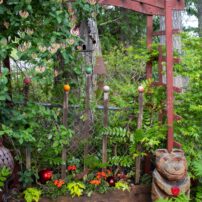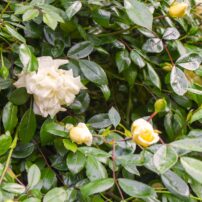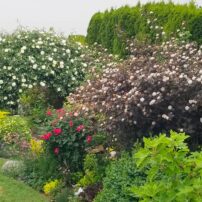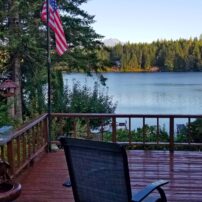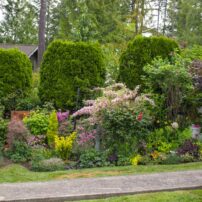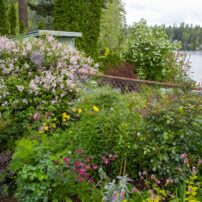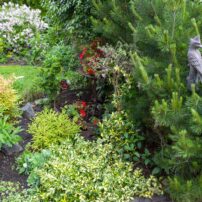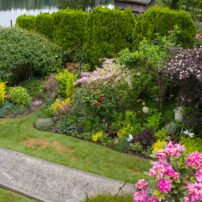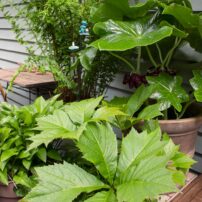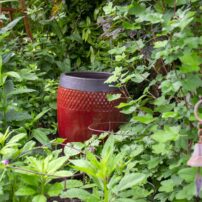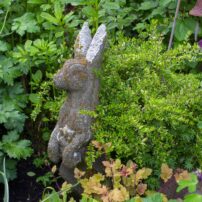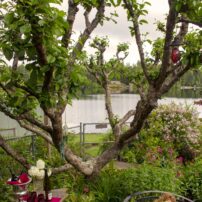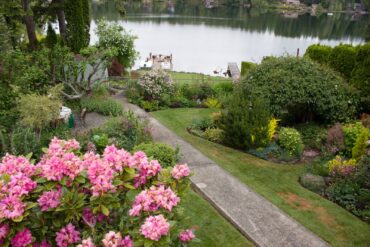 The magical view from the deck says it all — mountain peaks, placid lake and a garden that beckons you to leave the deck and wander through it to the water’s edge. This lovingly tended garden of Denice and Don Heblich on Wooten Lake in Tahuya is filled with love, creativity and an extreme level of garden prowess.
The magical view from the deck says it all — mountain peaks, placid lake and a garden that beckons you to leave the deck and wander through it to the water’s edge. This lovingly tended garden of Denice and Don Heblich on Wooten Lake in Tahuya is filled with love, creativity and an extreme level of garden prowess.
Don Heblich and a friend found the property nearly four decades ago, and together they bought the wooded site solely as a recreational property. The lot was overgrown with native trees, shrubs, salal, bracken fern and tangles of blackberry, and the men were not even aware there was a view of the Brothers Peaks visible over the hill on the other side of the lake.
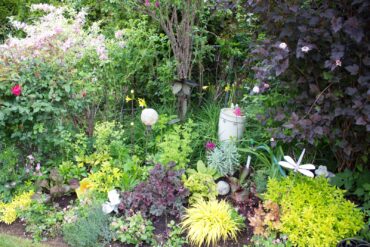 Once the land was cleared, they dug a well and divided the property into two lots. A gravel parking pad was installed at the top of the hill near the road, and Heblich built the bulkhead at the water’s edge.
Once the land was cleared, they dug a well and divided the property into two lots. A gravel parking pad was installed at the top of the hill near the road, and Heblich built the bulkhead at the water’s edge.
Two rockery terraces, along with concrete steps — one leading downhill from the road and another set nearer the water — were installed to allow for easier access to the water and the dock. Originally, the intended use was for camping and fishing retreats from busy lifestyles, but as all things evolve, the lakeside haven has now become a seasonal homesite for the Hebliches.
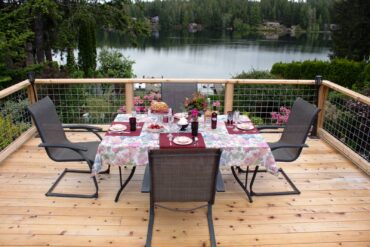 The couple began life at the lakeside in a 32-foot travel trailer 33 years ago and built the house in 1989. The lot was nothing but “hard, red dirt and rocks,” lamented Denice Heblich. To salve her longing for growing things, she gathered up some of those rocks and built a little walled garden, planting marigolds, violas and other flowering plants. She learned as she went along, discovering which flowers would thrive and which would not. Yellow snapdragons and nasturtiums are two that remain in her borders to this day.
The couple began life at the lakeside in a 32-foot travel trailer 33 years ago and built the house in 1989. The lot was nothing but “hard, red dirt and rocks,” lamented Denice Heblich. To salve her longing for growing things, she gathered up some of those rocks and built a little walled garden, planting marigolds, violas and other flowering plants. She learned as she went along, discovering which flowers would thrive and which would not. Yellow snapdragons and nasturtiums are two that remain in her borders to this day.
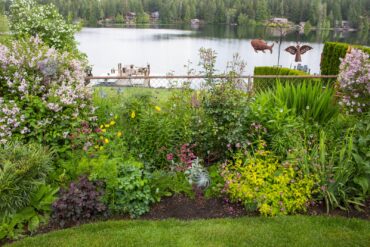 The couple met at the Puyallup Fair working as volunteers in the Tacoma Metro Parks Booth in the late 1980s. He was teaching off-road vehicle safety and she was distributing brochures on outdoor safety in general. Not long after this early introduction, friendship became love, followed by marriage, and the transition of a rough recreational property into a tended luxurious garden and homesite began to take root.
The couple met at the Puyallup Fair working as volunteers in the Tacoma Metro Parks Booth in the late 1980s. He was teaching off-road vehicle safety and she was distributing brochures on outdoor safety in general. Not long after this early introduction, friendship became love, followed by marriage, and the transition of a rough recreational property into a tended luxurious garden and homesite began to take root.
Denice is the head gardener, making the decisions for design, purchasing, sowing and nurturing plants from cuttings. As for Don’s involvement, he says with a wry smile, “I do as little as I can.” He’s the lawn guy, taking care of the mowing and helping with the edging.
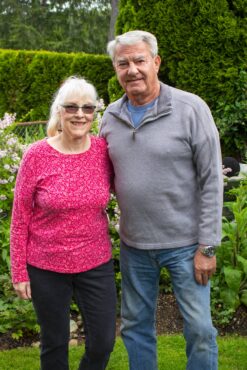
“He always is willing to help when I ask,” Denice Heblich says. He carries various bags of garden products up and down the hill, removes garden debris and helps with the heavy work.
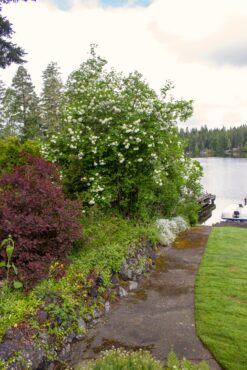 A pride and joy of the garden — and truly a showpiece when in bloom — is an antique rose, ‘Albéric Barbier.’ A semi-evergreen, shade-tolerant variety, it will climb a tree or cover an unsightly building if left to its own devices.
A pride and joy of the garden — and truly a showpiece when in bloom — is an antique rose, ‘Albéric Barbier.’ A semi-evergreen, shade-tolerant variety, it will climb a tree or cover an unsightly building if left to its own devices.
Denice’s mother had given her a redwood arbor for it years ago, but as the rose matured, it became much too heavy for the wooden structure. A windstorm blew the whole plant, which was fully budded at the time, to the ground, taking the arbor with it — a traumatic event for the gardener. Don Heblich came to the rescue by building a strong steel arbor for the rose, roping it into a bundle and reestablishing it on the new arbor. He worries a little about the weight and heft of the rose as it is today, and if his arbor is strong enough.
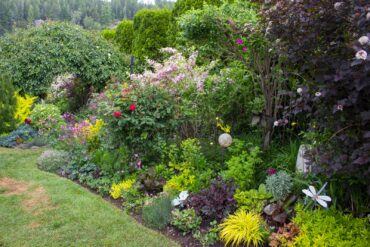 Denice smiles with pride at the little jobs Don likes to do around the garden, like building birdhouses and making decorative garden stakes with found items such as drawer pulls. He threads metal stakes so the finials will just screw on.
Denice smiles with pride at the little jobs Don likes to do around the garden, like building birdhouses and making decorative garden stakes with found items such as drawer pulls. He threads metal stakes so the finials will just screw on.
Don loves to sit on the deck while Denice is working in the garden, and reminds her when a particular shrub or tree is getting out of hand and might be obstructing their lovely view of the lake and beyond. She laughs and says, “He points out things I may have missed, while I work — grrr.”
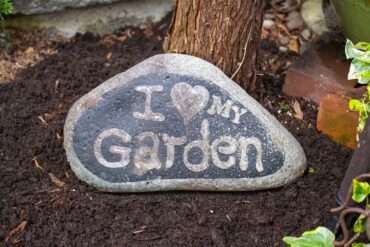 An intuitive gardener by nature, Denice Heblich learned her skill by growing up on a farm in Oregon. Her mother was a huge influence over her, encouraging Heblich to develop her own green thumb, and taught her to propagate plants simply by “sticking them in the ground and see what happens.” Although there are many methods for propagating plants, Heblich finds this the easiest and most effective. She is known among her garden friends for excelling at this technique. And so, over the past 33 years, from a rocky, bare lot has sprung a garden that friends clamor to visit and the Hebliches enjoy every moment they are in residence.
An intuitive gardener by nature, Denice Heblich learned her skill by growing up on a farm in Oregon. Her mother was a huge influence over her, encouraging Heblich to develop her own green thumb, and taught her to propagate plants simply by “sticking them in the ground and see what happens.” Although there are many methods for propagating plants, Heblich finds this the easiest and most effective. She is known among her garden friends for excelling at this technique. And so, over the past 33 years, from a rocky, bare lot has sprung a garden that friends clamor to visit and the Hebliches enjoy every moment they are in residence.
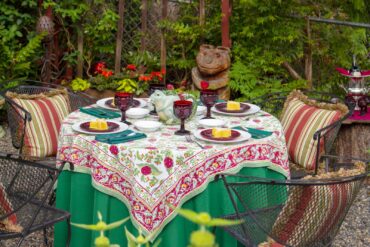 Two fences on each side border the narrow, 50-foot lot, separating it from neighbors’ properties. Both neighbors are also gardeners and have plants near their property lines. Denice takes advantage of this to expand the visual effect of her own garden.
Two fences on each side border the narrow, 50-foot lot, separating it from neighbors’ properties. Both neighbors are also gardeners and have plants near their property lines. Denice takes advantage of this to expand the visual effect of her own garden.
The neighbor on the right has planted a row of arborvitae, which serves as a lovely green backdrop for shrubs and perennials. The neighbor on the left makes changes in his garden as it matures, removing plants or pruning branches, but Denice uses the opportunity to pull her garden into his, taking advantage of the peekaboo spaces between his colorful maples and evergreens.
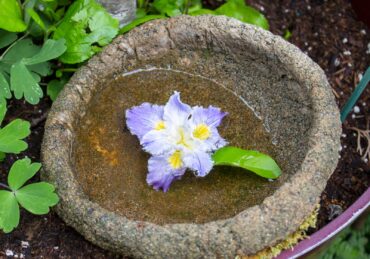 Being mindful of how her garden will work with those of the neighbors extends her space, the effect of her plants and, of course, her budget. An elegant, variegated yellow maple next door plays nicely with Denice’s Lady in Red hydrangea (which actually blooms blue) and a white Choisya ternata (Mexican orange).
Being mindful of how her garden will work with those of the neighbors extends her space, the effect of her plants and, of course, her budget. An elegant, variegated yellow maple next door plays nicely with Denice’s Lady in Red hydrangea (which actually blooms blue) and a white Choisya ternata (Mexican orange).
Other notable plants that anchor the long, meandering garden are Japanese maples for color and structure, a few conifers, a nine bark, a few Korean lilacs, the variegated weigela and the magnificent and elegant Hydrangea paniculata ‘Tardiva.’ Blooming shrubs and perennials fill the spaces between the larger plants, while little ground covers stitch the entire space together.
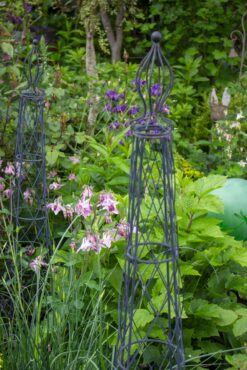 Denice Heblich is a master at layering plants, allowing the eye to travel from the ground up, with something interesting to see at all levels. She fills in spaces with interesting objets d’art, such as glazed pots brimming with colorful plants; birdhouses; stakes made from found objects like billiard balls, bits of mosaic; and even an old firepit surround.
Denice Heblich is a master at layering plants, allowing the eye to travel from the ground up, with something interesting to see at all levels. She fills in spaces with interesting objets d’art, such as glazed pots brimming with colorful plants; birdhouses; stakes made from found objects like billiard balls, bits of mosaic; and even an old firepit surround.
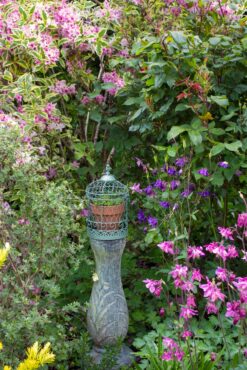 A surprising aspect of this garden is that the Hebliches are only in residence April through October each year. They split their time between the Pacific Northwest in the summer and the sunny climes of Arizona in the winter. When the couple returns here in the spring, they spend a good month or more working on winter cleanup, bringing tender plants out of the shelter of the garage and replanting containers.
A surprising aspect of this garden is that the Hebliches are only in residence April through October each year. They split their time between the Pacific Northwest in the summer and the sunny climes of Arizona in the winter. When the couple returns here in the spring, they spend a good month or more working on winter cleanup, bringing tender plants out of the shelter of the garage and replanting containers.
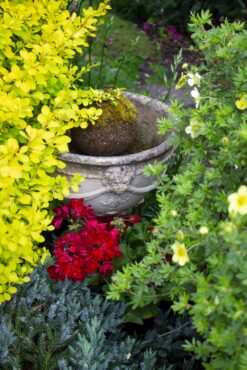 Looking to the future, Denice Heblich plans to integrate more conifers and other evergreens to give the garden more winter “bones.” Although she loves perennials, she is thinking about learning to work “smarter, not harder” by finding plants that require a minimum of maintenance.
Looking to the future, Denice Heblich plans to integrate more conifers and other evergreens to give the garden more winter “bones.” Although she loves perennials, she is thinking about learning to work “smarter, not harder” by finding plants that require a minimum of maintenance.
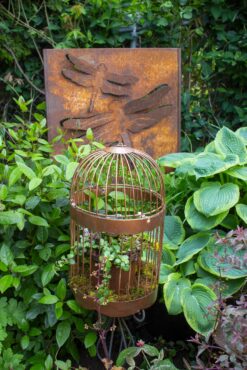 One trick she has developed in working smarter is putting together a tool bag she keeps by her side whenever she is in the garden. The tool kit contains small bottles of slug bait, plant food, clippers, a water bottle, mini saw, gloves, twine, plant markers, notebook and pen, kneeling pad and other items too numerous to mention. Carrying this tool kit with her eliminates numerous trips up and down the hill every time she needs something.
One trick she has developed in working smarter is putting together a tool bag she keeps by her side whenever she is in the garden. The tool kit contains small bottles of slug bait, plant food, clippers, a water bottle, mini saw, gloves, twine, plant markers, notebook and pen, kneeling pad and other items too numerous to mention. Carrying this tool kit with her eliminates numerous trips up and down the hill every time she needs something.
Heblich credits her design capabilities and vast knowledge of plants to her involvement in the local Northwest Perennial Alliance chapter, garden trips, open garden visits and hours of study at nurseries and garden centers. She has learned to make deep borders with lots of layers of plants, and island beds for interesting focal points.
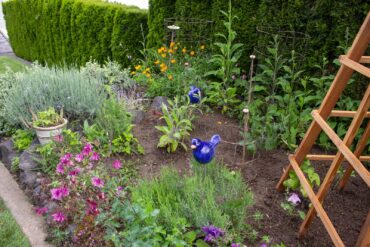 The cure for poor soil, such as the red rocky dirt she began with 33 years ago? Compost. Loads of compost! And keeping weeds at bay? She says, “Pull them as soon as you see them before they bloom and reseed, but also good mulch and ground covers prevent weeds in the first place.”
The cure for poor soil, such as the red rocky dirt she began with 33 years ago? Compost. Loads of compost! And keeping weeds at bay? She says, “Pull them as soon as you see them before they bloom and reseed, but also good mulch and ground covers prevent weeds in the first place.”
And what advice would this seasoned gardener most like to share with others? “Don’t be afraid to move a plant,” she says. If it isn’t doing well in one spot, move it to another. And finally, don’t be afraid to recycle plants. Even to the compost pile.”




